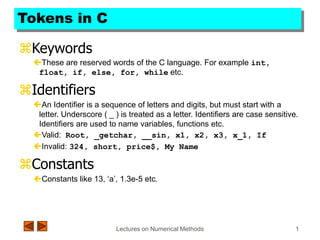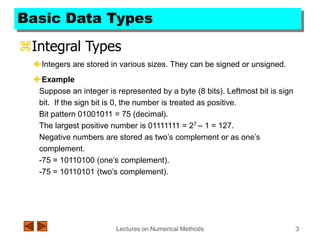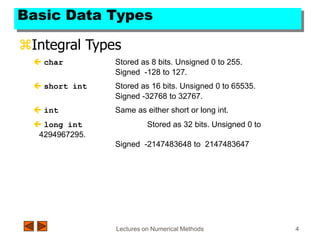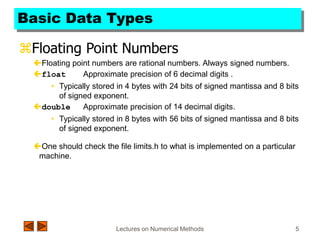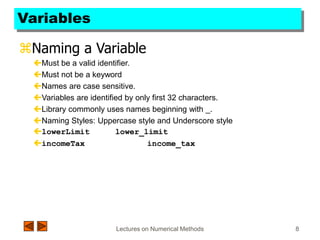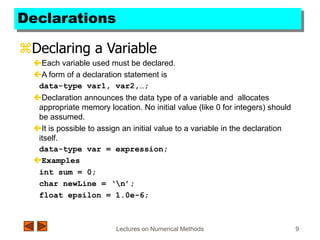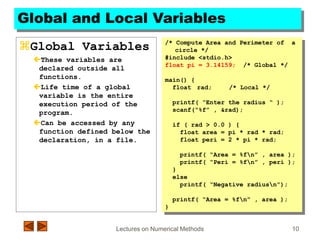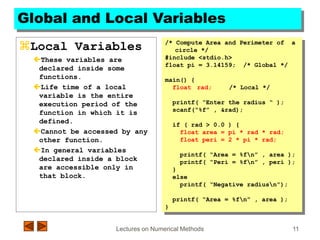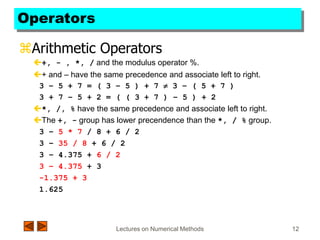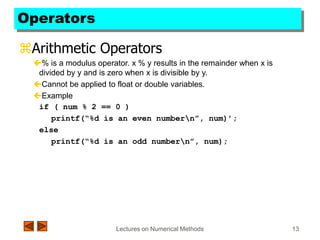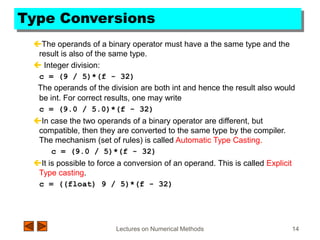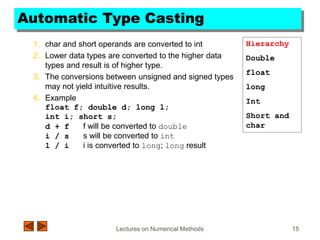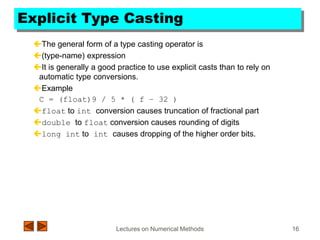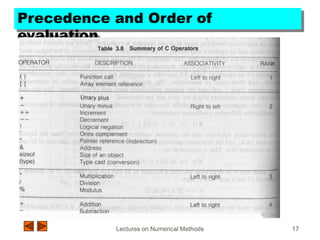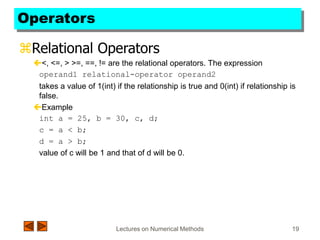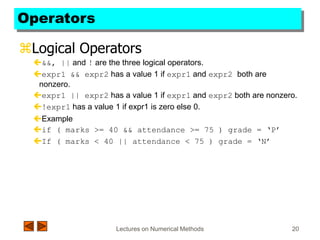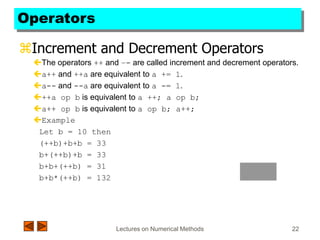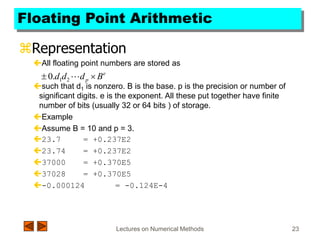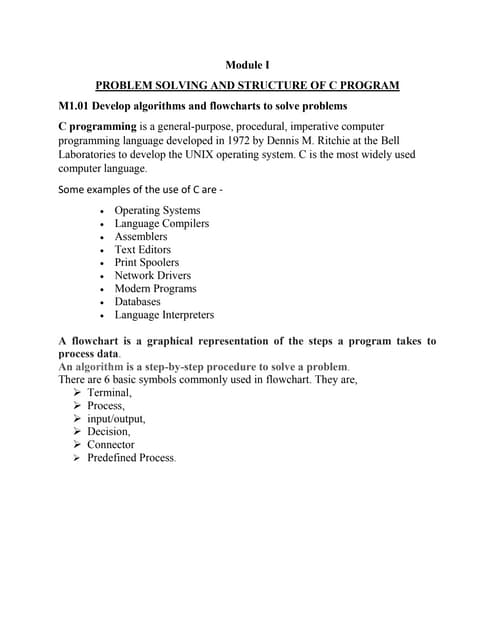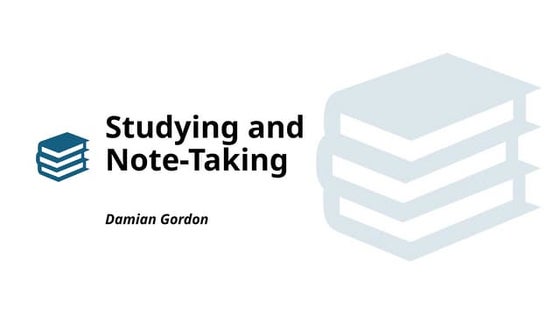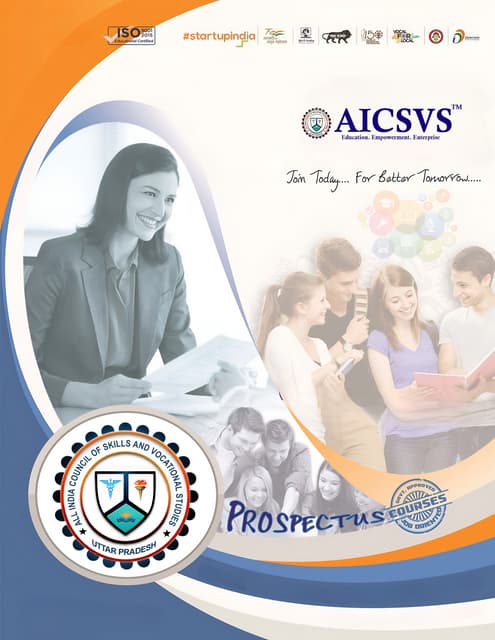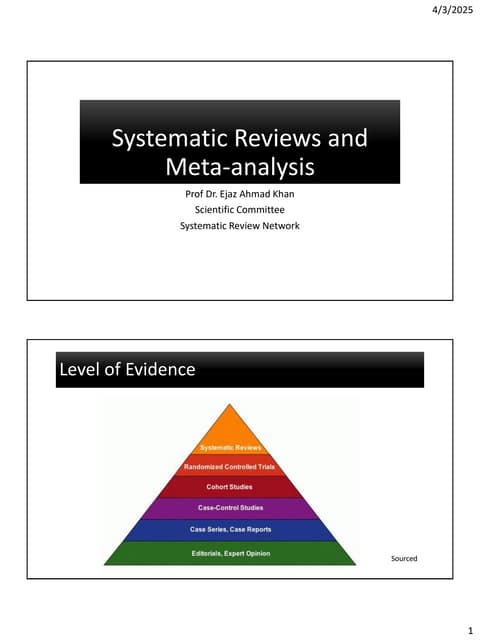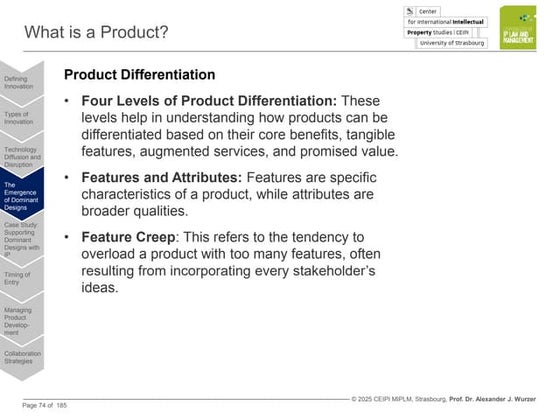Chapter-2 is for tokens in C programming
- 1. Lectures on Numerical Methods 1 Tokens in C ’ü║Keywords ’ā¦These are reserved words of the C language. For example int, float, if, else, for, while etc. ’ü║Identifiers ’ā¦An Identifier is a sequence of letters and digits, but must start with a letter. Underscore ( _ ) is treated as a letter. Identifiers are case sensitive. Identifiers are used to name variables, functions etc. ’ā¦Valid: Root, _getchar, __sin, x1, x2, x3, x_1, If ’ā¦Invalid: 324, short, price$, My Name ’ü║Constants ’ā¦Constants like 13, ŌĆśaŌĆÖ, 1.3e-5 etc.
- 2. Lectures on Numerical Methods 2 Tokens in C ’ü║String Literals ’ā¦A sequence of characters enclosed in double quotes as ŌĆ£ŌĆ”ŌĆØ. For example ŌĆ£13ŌĆØ is a string literal and not number 13. ŌĆśaŌĆÖ and ŌĆ£aŌĆØ are different. ’ü║Operators ’ā¦Arithmetic operators like +, -, *, / ,% etc. ’ā¦Logical operators like ||, &&, ! etc. and so on. ’ü║White Spaces ’ā¦Spaces, new lines, tabs, comments ( A sequence of characters enclosed in /* and */ ) etc. These are used to separate the adjacent identifiers, kewords and constants.
- 3. Lectures on Numerical Methods 3 Basic Data Types ’ü║Integral Types ’ā¦Integers are stored in various sizes. They can be signed or unsigned. ’ā¦Example Suppose an integer is represented by a byte (8 bits). Leftmost bit is sign bit. If the sign bit is 0, the number is treated as positive. Bit pattern 01001011 = 75 (decimal). The largest positive number is 01111111 = 27 ŌĆō 1 = 127. Negative numbers are stored as twoŌĆÖs complement or as oneŌĆÖs complement. -75 = 10110100 (oneŌĆÖs complement). -75 = 10110101 (twoŌĆÖs complement).
- 4. Lectures on Numerical Methods 4 Basic Data Types ’ü║Integral Types ’ā¦ char Stored as 8 bits. Unsigned 0 to 255. Signed -128 to 127. ’ā¦ short int Stored as 16 bits. Unsigned 0 to 65535. Signed -32768 to 32767. ’ā¦ int Same as either short or long int. ’ā¦ long int Stored as 32 bits. Unsigned 0 to 4294967295. Signed -2147483648 to 2147483647
- 5. Lectures on Numerical Methods 5 Basic Data Types ’ü║Floating Point Numbers ’ā¦Floating point numbers are rational numbers. Always signed numbers. ’ā¦float Approximate precision of 6 decimal digits . ŌĆó Typically stored in 4 bytes with 24 bits of signed mantissa and 8 bits of signed exponent. ’ā¦double Approximate precision of 14 decimal digits. ŌĆó Typically stored in 8 bytes with 56 bits of signed mantissa and 8 bits of signed exponent. ’ā¦One should check the file limits.h to what is implemented on a particular machine.
- 6. Lectures on Numerical Methods 6 Constants ’ü║Numerical Constants ’ā¦Constants like 12, 253 are stored as int type. No decimal point. ’ā¦12L or 12l are stored as long int. ’ā¦12U or 12u are stored as unsigned int. ’ā¦12UL or 12ul are stored as unsigned long int. ’ā¦Numbers with a decimal point (12.34) are stored as double. ’ā¦Numbers with exponent (12e-3 = 12 x 10-3 ) are stored as double. ’ā¦12.34f or 1.234e1f are stored as float. ’ā¦These are not valid constants: 25,000 7.1e 4 $200 2.3e-3.4 etc.
- 7. Lectures on Numerical Methods 7 Constants ’ü║Character and string constants ’ā¦ŌĆścŌĆÖ , a single character in single quotes are stored as char. Some special character are represented as two characters in single quotes. ŌĆśnŌĆÖ = newline, ŌĆśtŌĆÖ= tab, ŌĆśŌĆÖ = backlash, ŌĆśŌĆØŌĆÖ = double quotes. Char constants also can be written in terms of their ASCII code. ŌĆś060ŌĆÖ = ŌĆś0ŌĆÖ (Decimal code is 48). ’ā¦A sequence of characters enclosed in double quotes is called a string constant or string literal. For example ŌĆ£CharuŌĆØ ŌĆ£AŌĆØ ŌĆ£3/9ŌĆØ ŌĆ£x = 5ŌĆØ
- 8. Lectures on Numerical Methods 8 Variables ’ü║Naming a Variable ’ā¦Must be a valid identifier. ’ā¦Must not be a keyword ’ā¦Names are case sensitive. ’ā¦Variables are identified by only first 32 characters. ’ā¦Library commonly uses names beginning with _. ’ā¦Naming Styles: Uppercase style and Underscore style ’ā¦lowerLimit lower_limit ’ā¦incomeTax income_tax
- 9. Lectures on Numerical Methods 9 Declarations ’ü║Declaring a Variable ’ā¦Each variable used must be declared. ’ā¦A form of a declaration statement is data-type var1, var2,ŌĆ”; ’ā¦Declaration announces the data type of a variable and allocates appropriate memory location. No initial value (like 0 for integers) should be assumed. ’ā¦It is possible to assign an initial value to a variable in the declaration itself. data-type var = expression; ’ā¦Examples int sum = 0; char newLine = ŌĆśnŌĆÖ; float epsilon = 1.0e-6;
- 10. Lectures on Numerical Methods 10 Global and Local Variables ’ü║Global Variables ’ā¦These variables are declared outside all functions. ’ā¦Life time of a global variable is the entire execution period of the program. ’ā¦Can be accessed by any function defined below the declaration, in a file. /* Compute Area and Perimeter of a circle */ #include <stdio.h> float pi = 3.14159; /* Global */ main() { float rad; /* Local */ printf( ŌĆ£Enter the radius ŌĆ£ ); scanf(ŌĆ£%fŌĆØ , &rad); if ( rad > 0.0 ) { float area = pi * rad * rad; float peri = 2 * pi * rad; printf( ŌĆ£Area = %fnŌĆØ , area ); printf( ŌĆ£Peri = %fnŌĆØ , peri ); } else printf( ŌĆ£Negative radiusnŌĆØ); printf( ŌĆ£Area = %fnŌĆØ , area ); }
- 11. Lectures on Numerical Methods 11 Global and Local Variables ’ü║Local Variables ’ā¦These variables are declared inside some functions. ’ā¦Life time of a local variable is the entire execution period of the function in which it is defined. ’ā¦Cannot be accessed by any other function. ’ā¦In general variables declared inside a block are accessible only in that block. /* Compute Area and Perimeter of a circle */ #include <stdio.h> float pi = 3.14159; /* Global */ main() { float rad; /* Local */ printf( ŌĆ£Enter the radius ŌĆ£ ); scanf(ŌĆ£%fŌĆØ , &rad); if ( rad > 0.0 ) { float area = pi * rad * rad; float peri = 2 * pi * rad; printf( ŌĆ£Area = %fnŌĆØ , area ); printf( ŌĆ£Peri = %fnŌĆØ , peri ); } else printf( ŌĆ£Negative radiusnŌĆØ); printf( ŌĆ£Area = %fnŌĆØ , area ); }
- 12. Lectures on Numerical Methods 12 Operators ’ü║Arithmetic Operators ’ā¦+, - , *, / and the modulus operator %. ’ā¦+ and ŌĆō have the same precedence and associate left to right. 3 ŌĆō 5 + 7 = ( 3 ŌĆō 5 ) + 7 ’é╣ 3 ŌĆō ( 5 + 7 ) 3 + 7 ŌĆō 5 + 2 = ( ( 3 + 7 ) ŌĆō 5 ) + 2 ’ā¦*, /, % have the same precedence and associate left to right. ’ā¦The +, - group has lower precendence than the *, / % group. 3 ŌĆō 5 * 7 / 8 + 6 / 2 3 ŌĆō 35 / 8 + 6 / 2 3 ŌĆō 4.375 + 6 / 2 3 ŌĆō 4.375 + 3 -1.375 + 3 1.625
- 13. Lectures on Numerical Methods 13 Operators ’ü║Arithmetic Operators ’ā¦% is a modulus operator. x % y results in the remainder when x is divided by y and is zero when x is divisible by y. ’ā¦Cannot be applied to float or double variables. ’ā¦Example if ( num % 2 == 0 ) printf(ŌĆ£%d is an even numbernŌĆØ, num)ŌĆÖ; else printf(ŌĆ£%d is an odd numbernŌĆØ, num);
- 14. Lectures on Numerical Methods 14 Type Conversions ’ā¦The operands of a binary operator must have a the same type and the result is also of the same type. ’ā¦ Integer division: c = (9 / 5)*(f - 32) The operands of the division are both int and hence the result also would be int. For correct results, one may write c = (9.0 / 5.0)*(f - 32) ’ā¦In case the two operands of a binary operator are different, but compatible, then they are converted to the same type by the compiler. The mechanism (set of rules) is called Automatic Type Casting. c = (9.0 / 5)*(f - 32) ’ā¦It is possible to force a conversion of an operand. This is called Explicit Type casting. c = ((float) 9 / 5)*(f - 32)
- 15. Lectures on Numerical Methods 15 Automatic Type Casting 1. char and short operands are converted to int 2. Lower data types are converted to the higher data types and result is of higher type. 3. The conversions between unsigned and signed types may not yield intuitive results. 4. Example float f; double d; long l; int i; short s; d + f f will be converted to double i / s s will be converted to int l / i i is converted to long; long result Hierarchy Double float long Int Short and char
- 16. Lectures on Numerical Methods 16 Explicit Type Casting ’ā¦The general form of a type casting operator is ’ā¦(type-name) expression ’ā¦It is generally a good practice to use explicit casts than to rely on automatic type conversions. ’ā¦Example C = (float)9 / 5 * ( f ŌĆō 32 ) ’ā¦float to int conversion causes truncation of fractional part ’ā¦double to float conversion causes rounding of digits ’ā¦long int to int causes dropping of the higher order bits.
- 17. Lectures on Numerical Methods 17 Precedence and Order of evaluation
- 18. Lectures on Numerical Methods 18 Precedence and Order of evaluation
- 19. Lectures on Numerical Methods 19 Operators ’ü║Relational Operators ’ā¦<, <=, > >=, ==, != are the relational operators. The expression operand1 relational-operator operand2 takes a value of 1(int) if the relationship is true and 0(int) if relationship is false. ’ā¦Example int a = 25, b = 30, c, d; c = a < b; d = a > b; value of c will be 1 and that of d will be 0.
- 20. Lectures on Numerical Methods 20 Operators ’ü║Logical Operators ’ā¦&&, || and ! are the three logical operators. ’ā¦expr1 && expr2 has a value 1 if expr1 and expr2 both are nonzero. ’ā¦expr1 || expr2 has a value 1 if expr1 and expr2 both are nonzero. ’ā¦!expr1 has a value 1 if expr1 is zero else 0. ’ā¦Example ’ā¦if ( marks >= 40 && attendance >= 75 ) grade = ŌĆśPŌĆÖ ’ā¦If ( marks < 40 || attendance < 75 ) grade = ŌĆśNŌĆÖ
- 21. Lectures on Numerical Methods 21 Operators ’ü║Assignment operators ’ā¦The general form of an assignment operator is ’ā¦v op= exp ’ā¦Where v is a variable and op is a binary arithmetic operator. This statement is equivalent to ’ā¦v = v op (exp) ’ā¦a = a + b can be written as a += b ’ā¦a = a * b can be written as a *= b ’ā¦a = a / b can be written as a /= b ’ā¦a = a - b can be written as a -= b
- 22. Lectures on Numerical Methods 22 Operators ’ü║Increment and Decrement Operators ’ā¦The operators ++ and ŌĆō- are called increment and decrement operators. ’ā¦a++ and ++a are equivalent to a += 1. ’ā¦a-- and --a are equivalent to a -= 1. ’ā¦++a op b is equivalent to a ++; a op b; ’ā¦a++ op b is equivalent to a op b; a++; ’ā¦Example Let b = 10 then (++b)+b+b = 33 b+(++b)+b = 33 b+b+(++b) = 31 b+b*(++b) = 132
- 23. Lectures on Numerical Methods 23 Floating Point Arithmetic ’ü║Representation ’ā¦All floating point numbers are stored as ’ā¦such that d1 is nonzero. B is the base. p is the precision or number of significant digits. e is the exponent. All these put together have finite number of bits (usually 32 or 64 bits ) of storage. ’ā¦Example ’ā¦Assume B = 10 and p = 3. ’ā¦23.7 = +0.237E2 ’ā¦23.74 = +0.237E2 ’ā¦37000 = +0.370E5 ’ā¦37028 = +0.370E5 ’ā¦-0.000124 = -0.124E-4 e p B d d d ’é┤ ’é▒ ’üī 2 1 . 0
- 24. Lectures on Numerical Methods 24 Floating Point Arithmetic ’ü║Representation ’ā¦Sk = { x | Bk-1 <= x < Bk }. Number of elements in each Sk is same. In the previous example it is 900. ’ā¦Gap between seuccessive numbers of Sk is Bk-p. ’ā¦B1-p is called machine epsilon. It is the gap between 1 and next representable number. ’ā¦Underflow and Overflow occur when number cannot be represented because it is too small or too big. ’ā¦Two floating points are added by aligning decimal points. ’ā¦Floating point arithmetic is not associative and distributive.
